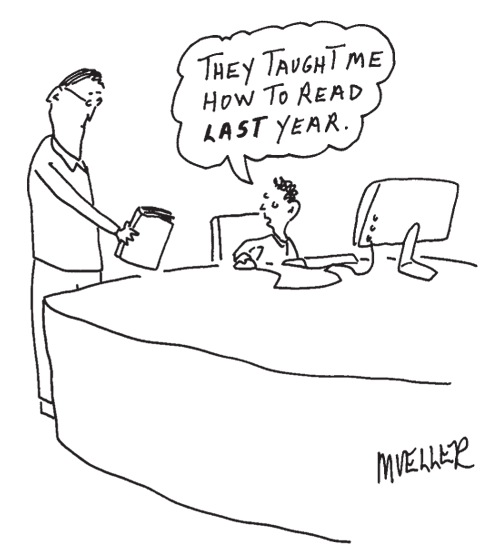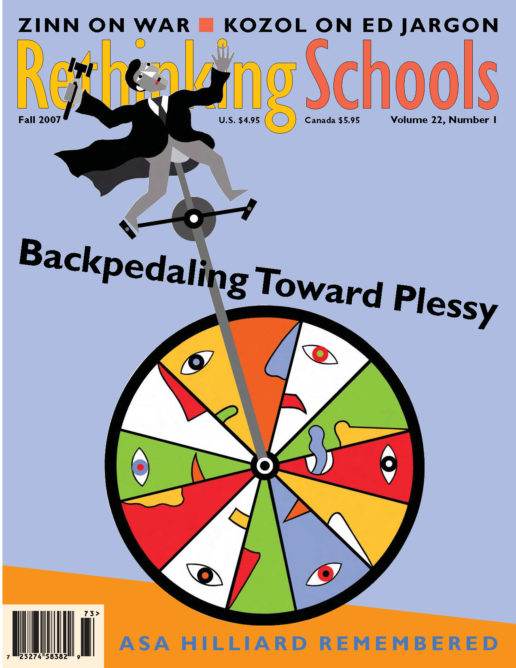Letters to the Editors 22.1
Haikus Lift Students

Prior to teaching my 6th graders about Japanese haiku, we had heard a talk by Dr. Dahlia Wasfi, an Iraqi-American, who conveyed to kids some of the realities on the ground in Iraq. I was inspired by Bob Peterson’s article “The War in Iraq and Daily Classroom Life” [Vol. 21, No. 3] to initiate a deeper dialogue around the war, and I shared with my students some of the war poetry from Peterson’s 5th graders. I then encouraged my students to select a theme for their haiku poems. Many struggled with the 5-7-5-syllable structure of haiku, not to mention the challenging “turn of phrase” in the last line, and I was becoming discouraged reading some of the pieces until I read this one by 11-year-old Luis:
Army men are strong
and their guns are really big
but they are home sick.
The poignancy of this poem just stunned me. Luis’s haiku was a surprise, not because of its craftsmanship, although the double meaning in “home sick” and the overall sad truth and irony of the poem are really moving, but the fact that the kids really do absorb some of the humanity that can be presented in the curriculum. (Or, so I would like to believe — maybe Luis was already there.) I am slowly coming to the realization that if you leave the teaching to the mainstream American culture — or, in other words, if you do not stand up to our very shallow culture — then a lot of our students will naturally gravitate toward its regressive and unhealthy nature.
But sometimes it is true, too, your students are who they are. Here is Stephanie’s beautiful haiku, marching to her own drummer:
Mother horse watches
her baby drink from a stream
soon she will leave her.
– Brett Drugge
Gage Middle School
Huntington Park, Calif.
Thank You, Linda
I am writing to thank Linda Christensen for her article: “Raised by Women: Building Relationships through Poetry” [Vol. 21, No. 3]. After reading it, I decided to use her idea to write a poem for my mother in honor of her 74th birthday. I invited my eight siblings to do the same.
The completed poems that we presented to my mother were humorous, thoughtful, poignant, and sad. As my mother read them, she laughed, cried, and remembered. What a fabulous gift to see my mother experience the breadth and depth of her motherhood through our memories as they were revealed in the varying ways we crafted our poems.
I plan to integrate the article and the accompanying activity into a multicultural course I am teaching this fall at Hellenic College in Brookline, Mass. I will invite a group of undergraduate students enrolled in the college’s elementary education program to read and discuss the piece. I will then ask the students to create poems related to how they were “taught” while attending elementary school.
I have been using materials published by Rethinking Schools in my classes for many years. I applaud your continued efforts to inspire those of us fortunate enough to have access to them and thank you for the much needed work you all engage in.
– Alice McIntyre
Boston, Mass.
Rethinking ‘Freedom Writers’
I think Chela Delgado’s review of Freedom Writers [Vol. 21 No. 3] provokes thought, so it’s a good thing. But I think she’s missing some of the virtues of the film.
Yes, the teacher’s white. She couldn’t help that, but instead of falling into the generally accepted trap of teaching the curriculum and blaming the kids for their failures, she actually tries to do her job — and succeeds. Delgado’s absolutely right that the resources should be there, that having extra jobs and losing touch with your husband shouldn’t be collateral damage when you’re trying to teach.
Yes, the parents are seen unsympathetically. However, if the film were (properly) subtitled “A teacher learns to be there for her class,” then the burdens of the parents, insofar as they are transmitted to the kids, are part of her learning.
I’ll take this lesson from the review: On two listservs, Reggio-L and TAWL, I correspond daily with teachers who are doing amazing things in their classrooms. I’ve asked teachers of color on those listservs to consider writing a teacher movie that speaks to their experience. I imagine the scripts offered to movie studios are almost entirely from white people, who have more time, privilege, etc. I’m not arguing that at all. But if we want a perspective of color, we’ll need to have writing from people of color, who are, as Delgado rightly points out, busy living their lives in a racist society that makes that hard.
Yes, the film doesn’t attack the big racist picture. But that’s exactly the same kind of criticism that was leveled against Alice Walker’s The Color Purple. The reply then and now is that a film isn’t all of life; it’s a slice of life. And if it’s true, it’s a useful slice; we mustn’t think all black men are awful because of characters in The Color Purple, and we mustn’t think Gruwell’s methods are going to clean up the mess our schools are in. Yet, an oppressed woman can find her way in the Walker story, and in the Gruwell story, a teacher can help kids, does what she must to help kids. What she’s doing is leveling the playing field. That’s what white allies of people of color do. It is the people of color who do the rest, and they put the lie to the myth that kids of color don’t have it in them.
There are all these awful things standing in the way of teachers of any color helping kids and we, the audience, must try to make some difference there. It’s the year to bring down No Child Left Behind. Let’s all do what we can in our own ways, and let’s support any efforts we see to bring it down in an organized way, and let’s be glad for any clues to how people can learn.
– Sydney Gurewitz Clemens
San Francisco, Calif.
Dept. of Ed Called Out
In his insightful article “Exit Strategies” [Vol. 22, No. 4], Stan Karp argues that tests mandated by NCLB have not provided useful data that will result in better instruction. Actually, they have. They have shown that No Child Left Behind and Reading First have not resulted in improved reading.
Reading First provides an extra 100 minutes a week of instruction, approximately an extra semester every two years. If Reading First is at all effective, the impact should be obvious. It isn’t.
On the basis of data released in April, the U.S. Department of Education claimed that between 2004 and 2006, the percentage of 3rd graders in Reading First meeting or exceeding the proficient level increased 12 percent on tests of reading comprehension and 15 percent on tests of fluency. Re-analysis revealed, however, that the gain in reading comprehension was only 6 percent and in fluency, it was 9 percent. Also, these gains mask the fact that some states did poorly: Pennsylvania declined 10 percent in reading comprehension.
It also needs to be pointed out that the test used in most states to measure fluency, Dibels, has serious problems. It is also easily available on the Internet, which means any teacher or parent can drill their children on the actual test items. In addition, the Department of Education violated a fundamental scientific principle: There was no comparison group. Any increases could have been due to factors other than Reading First.
The most recent report, from the Center on Education Policy, was also interpreted by the administration as showing that NCLB-related programs have been a success. Again, no comparison group was included, but the center’s report included data on elementary school gains for the two years before and two years after NCLB was implemented in 11 states. Before NCLB, the yearly rate of improvement in these states was 1.2 percent, that is, 1.2 percent more students were classified as proficient. After NCLB, it was 1.51 percent, a difference of less than one third of 1 percent.
In other words, reading scores were going up before NCLB and NCLB did little or nothing to improve the rate of improvement.
Before these two reports, the Department of Education had claimed that NCLB had improved 4th-grade National Assessment of Educational Progress reading scores. Several analyses showed, however, that the gains came before NAEP was implemented.
There is, so far, no evidence that this expensive and time-consuming experiment has improved the reading ability of American children.
– Stephen Krashen
Los Angeles, Calif.

